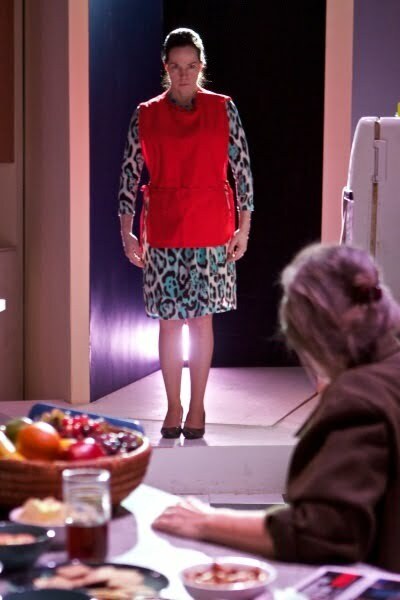Maria/Stuart
Directed by Marti Lyons
Starring Nate Whelden, Scottie Caldwell, Mary Anne Bowman,
Ann James, Susan Monts-Bologna & Jennifer Joan Taylor
Presented by Sideshow Theater Company
Playing at Theater Wit
This ambitious and boldly conceived play nonetheless suffers from a lack of human touch.
Featuring a shape-shifting Changeling with a love for soda pop, a woman with hooks for hands, and a menacing family secret, the Chicago premiere of Jason Grote’s Maria/Stuart succeeds in getting our attention. Yet for all its colorful originality, the play’s use of magical realism tends to overwhelm its otherwise all-too-human story underneath—as a dissonant orchestra might overwhelm a frail whisper—coating on layers of the wildly uncanny even as its more humane dimensions slip away from it.
Stuart (Nate Whelden), a recognizably awkward young man with a passion for writing comic books, has since childhood been harboring a secret from his mother Marnie (Jennifer Joan Taylor), a woman so neurotically overwhelmed that she is incapable of thinking of anyone but herself. Not that the rest of Stuart’s family is any better. His Aunt Lizzy (Mary Anne Bowman) launches into hysterics over nothing bigger than a jar of olives, her insane perfectionism often bubbling over into Tourette-like bouts of rage. And Aunt Sylvia (Ann James), who lost her hands in a horrific suicide attempt years ago, has all the doting innocence of a child that must be perpetually looked after.
And were this not strange enough, Stuart harbors slightly incestuous feelings for his cousin, Hannah (Scottie Caldwell), a young woman rightly plagued by a sense of being stuck in her family and in her life. Oddly enough, it is Stuart’s grandmother Ruthie (Susan Monts-Bologna), rolling cool grapes over the skin of her hands, who seems most at ease with herself. Though not for long.
For crashing into the lives of this quintessential suburban family comes the Changeling, a wraith-like creature who sonorously promises deliverance from the past in an arcanely poetic style whilst downing whole liters of soda pop. An ominous figure from Aunt Sylvia’s past, the Changeling—able to take on the appearance of anyone in the family—is a symbolic manifestation of their egregious sins against one another, sins which by the end of the play must either be painfully acknowledged or forcibly repressed.
Unfortunately, such bizarrely preternatural devices only work insofar as the audience buys the real human drama unfolding beneath them, and that seems to be the place where Grote’s play feels most underdeveloped. For characters who at the outset of Maria/Stuart appear imbued with real feelings and real motivations only grow grotesque and exaggerated as the play’s bizarre logic slowly deforms their inner emotional lives. The result is that by the end of Marie/Stuart, we no longer feel ourselves to be dealing with real people—only the contorted mask-like expressions of rage, anger and denial. And without a well-textured layer of emotional reality to anchor our engagement, the play’s uncanny elements soon drift ever-closer to the realm of abstract symbolism. The result is that Grote’s clamorous climax lands like a hollowed idea across the stage. Because we don’t buy the emotional logic that brings Stuart’s self-revelation from A to B, we are less impressed by the admittedly visceral scene in which it unfolds.
Performances in Maria/Stuart are equally successful insofar as they are able to resist the play’s own tendencies toward the abstract. Thus Susan Monts-Bologna as the aged Ruthie gives far and away the production’s most earthbound performance, wearing the old woman’s skin with such an ease of expression and subtle good humor that you’d swear you were in her actual kitchen. At the other extreme is Mary Anne Bowman’s rendition of the frantic Aunt Lizzy, her limbs tensely angular, her gestures strangely expressionist, and her voice weirdly modulated. Yet perhaps the wildly divergent performance styles of Monts-Bologna and Bowman—with the remaining performances falling somewhere in-between—only highlight the tonal ambiguities already latent in Grote’s own play.
Maria/Stuart’stitle is a pun on the rhetorical tragedy Maria Stuart written in 1800 by Friedrich Schiller (whose bust features conspicuously in Grote’s play). Though beyond perhaps slight similarities to the Strum and Drang school, I’m afraid the reference is lost on me. A more apt precursor here would be the family romances of Sam Shepard, most clearly his Fool for Love. Shepard’s own interests in the incestuous family romance, his uses of magical realism, and the ways in which his plays descend from sadness in a menacing uncertainty foreground much of what Grote seems to be gesturing toward.
As is, Marie/Stuart may succeed in startling you out of your seat a bit, even as it leaves you scratching your head.
SOMEWHAT RECOMMENDED
Anthony J. Mangini
Reviewed Friday, April 5th, 2013.
Maria/Stuart runs until May 5th, 2013. Theater Wit is located at 1229 W. Belmont Ave. Chicago, IL 60657. Check out their Theater in Chicago listing at https://www.theatreinchicago.com/mariastuart/6064/.



